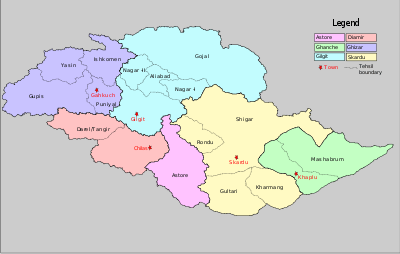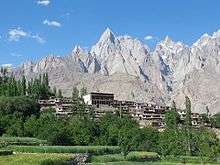Skardu District
| Skardu District | |
|---|---|
| District | |
| Country | Pakistan |
| Province | Gilgit-Baltistan |
| Division | Baltistan |
| Established | July 1, 1970 |
| Capital | Skardu |
| Area | |
| • Total | 15,000 km2 (6,000 sq mi) |
| Population | |
| • Total | 214,848 |
| Time zone | PST (UTC+5) |
| Number of Tehsils | 4 |


Skardu District (Urdu: ضلع سکردو) is part of Baltistan and currently constitutes one of the ten districts of the Gilgit–Baltistan territory of Pakistan. It is bounded on the southeast by Kargil district in the Indian-Administered Jammu and Kashmir, on the east by Ghanche District, on the northeast by Xinjiang (China), on the south by Baramulla and Kargil District, on the west by district Astore and on the north by Gilgit District.
Skardu town is the capital of Skardu District and Baltistan Division.
Mountain peaks and glaciers
The highest peak in Skardu District is K2 (8,611 m) which is the highest peak in Pakistan and the second highest peak on earth. The Baltoro Muztagh (the subrange of Karakoram that includes the mighty peaks of K2 (8,611 m), Broad Peak (8,047 m), Gasherbrum (8,000+ m) and Masherbrum (7,821 m) lie in the Skardu District. Askole is the last settlement in the district for all treks to Concordia (the confluence of Baltoro Glacier and Godwin-Austen Glacier). The Biafo Glacier and a major part of Hispar Glacier are also included in the Skardu District.
History of Baltistan
The Historical Mosque "Chaqchan Khanqah" located in Khaplu Distt. Ghanche
In the 14th century the Buddhist population of Baltistan, Kargil and some villages of Ladakh converted into Muslim as a result of preaching of Syed Ali Hamdani (714-786 al hija) – a saint and Islamic scholar of Kobravi sufi order followed by preaching of Syed Muhammad Nurbakhsh (795-859 alhijra) a disciple of Khawaja Ishaq Khatlani himself the principal successor of Syed Ali Hamdani of same Kubravi Sufi Order. Thus a Muslim society developed first time in the Northern Areas of subcontinent
This Muslim society apart from Quran and Sunnah follows Al-Fiqatul Akhwat consisting of legal provisions (furu) and Usool Aitaqadia consisting of principles (Usool-e-Islam) written by Syed Mohammad Nurbakhsh. Therefore they are named Sufia Nurbakshia such as Shia Jafferia and Sunni Hanifia.
Nurbakhshis fundamentally like Ahle Sunnat & Ahle Shia believe in God, angels, holy books, Mohammed and last day judgment with oral declaration of Kalma-e- Shahadat and practically offering of five time prayers, fasting during Ramdan, Zakattul Mall (charity of wealth) and performance of Hajj, subject to availability of resources.
As interpreted by Arabic Dictionary Ul-Monjid in the Alfiqatul Ahwat a middle way between Shia and Sunni teachings is shown as a Shariat-e-Islmia. Mission of Syed Muhammad Nurbakhsh as proclaimed by both Shia and Shinn School of thoughts because of their teachings as introductory page Al-Fiqatul Ahwat has been to unify all different sects of Islam, by following Shria prevailing during abeying the lifetime of Mohammed.
Nurbakhshis are known as peaceful, tolerable and moderates, who not only equally respect other Muslim school of thoughts but also stress upon to behave human beings lovely – In the chapter relating to Mrar-bil- Maroof wa Nahi anil Munkar Alfiqatual Ahwat the aim of Islamic pravaling is defined to be obeying God's order and becoming kind to His creature.
In the Zikharatul Malook by quoting a Saying (HADITH) of Mohammed reported by Hazarat Imam Hussain the prime wisdom after accomplishment of religious duties is to love human beings and without regarding his being good or bed to do good deeds to every one.
Syed Ali Hamdani by quoting a Hadith of Mohammed says that those who are protectors of lives and properties of human being are Momin ( real believers) while Syed Mohammad Nurbakhsh says that a Momin ( believer) refrains himself from great sinful deeds ( Gona-e-Kabira) like Shireek, killing/ Murder, docorty theft forgery and cheatings etc.
Syed Ali Hamdani and Syed Muhammad Nurbakhsh are claimed by both Shia and Sunni probably because of their teachings stressing upon the Moadat-e- Ahlibeit and the need of following Sunnah of Mohammed apart fiqatual Ahwat permits different style of praying preachers agreeable to Shia and Sunni as optional.
Syed Ali Hamdani wrote about 170 books, pamphlets leaf lets handouts of which about 70 are traced in either published or unpublished shape. Similarly Syed Mohammad Nurbakhsh is an author of about one and half dozen books in Arabic or Persian.
In the Nurbakhshi Mosque called Khanqah adjacent to main praying halls small rooms are provided for the purpose solitary praying (Atikaf). These Khanqahs have been using as a central couching and preaching place by the Nurbakhshia.
It is said that followers of Nurabkhshis Maslak do exist in central Asia specially Tajkistan, Siangkang and Yarqand provinces of China, Turkey Kurdistan and Iran. But present day Nurbakhshis do not have any linkage with Nurabkhshis living in other parts of world out side sub-continent.
Barat Library Khaplu and Suffa Islamic Library Madarasa Shah-e-Hamdan Sufia Noorbakhsh can become main source for searching further detail about Nurbakhshisium.
Education
According to the Alif Ailaan Pakistan District Education Rankings 2015, Skardu is ranked 14 out of 148 districts in terms of education. For facilities and infrastructure, the district is ranked 89 out of 148. [1]
Deosai National Park
Deosai is one of the highest plains in the world. The district shares the territorial limits of Deosai National Park with Astore which has major portion, (second highest plains after Tibet). The Indus River enters the Gilgit–Baltistan territory from Ladakh.
Other towns
Other towns in the Skardu District include: Skardu, Roundu - Sub-Division, Parkutta, Sermik, Hussainabad, and Mehdiabad, Sadpara.
Mountain passes
Hispar Pass and Gondoghoro Pass are also in the Skardu District. Skardu is a beautiful place where 8o % people are Shia, 15% are Noorbakshia Islam and few are Sunni in Skardu city. Most of people are very simple and they don't want to take complexity in life and they often use old living life style. Manthokha
Lakes
Some of the lakes in the district are Snow Lake, Satpara Lake, Sheosar Lake, Kachura Lake and Shangrila Lake.
See also
References
- ↑ "Individual district profile link, 2015". Alif Ailaan. Retrieved 2015-05-07.
External links
| Wikimedia Commons has media related to Skardu District. |
